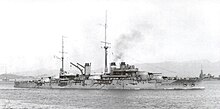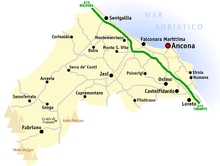Adriatic Campaign of World War I
Allied forces mainly limited themselves to blockading the Central Powers' navies in the Adriatic, which was successful in regards to surface units, but failed for the U-boats, which found safe harbours and easy passage into and out of the area for the whole of the war.He had orders to sail with all available French and British ships, pass into the Adriatic Sea, and undertake whatever operations he thought best against Austrian ports.The main Allied force comprised the French battleships Courbet and Jean Bart, and the cruiser Jurien de la Gravière.The Anglo-French force succeeded in cutting off and sinking the old Austro-Hungarian light cruiser SMS Zenta off Bar on 16 August in the Battle of Antivari.The French and Montenegrin forces attempted to cause havoc also at Cattaro in September, October and November 1914, and the Austro-Hungarian navy was called in there also, resulting in a decisive defeat for the Allies.In November, the French submarine Cugnot managed to slip into the Bocche di Cattaro as far as Topla Bay but was chased out by the Austrian destroyer SMS Blitz, and the torpedo boat Tb 57T.In April, the Austrian U-5—commanded by Lt. Georg Ritter von Trapp—chased the French armoured cruiser Victor Hugo off Paxos, but was unable to fire any torpedoes.U-5 also torpedoed the French armoured cruiser Léon Gambetta after a two-day chase off Santa Maria di Leuca, causing 684 fatalities including Rear-Admiral Sénès.The Radetzky-class semi-dreadnought SMS Zrínyi, with two torpedo boats bombarded Senigallia, destroying a train and damaging a railway station and a bridge, then returned to Pola.On 9 June, a mixed force of British, French and Italian destroyers shelled the Austro-Hungarian signal station at Cape Rondini in Albania.On 13 August, U-3 was sunk at Brindisi by the French destroyer Bisson, after having been severely damaged by the Italian auxiliary cruiser Città di Catania the day before.In early December, the French submarine Fresnel ran aground off the Bojana River estuary due to bad navigation, and was sunk by the Austrian destroyer SMS Warasdiner.The cruiser Helgoland and three destroyers sortie against the Otranto Barrage from 5–22 December and performed reconnaissance off the Albanian coast and San Giovanni di Medua.Early in the afternoon of 29 December, the forward Allied ships came into action with the retreating Austrian light squadron, which was still only halfway home.The very same day, the French submarine Ampére scored two torpedo hits on the Austro-Hungarian Hospital ship No I (the former Lloyd steamer Elektra) off Cape Planka (Rt Ploča), causing two fatalities.For further assistance, the Italian destroyers Giuseppe Cesare Abba, Ippolito Nievo and Rosolino Pilo left Brindisi shortly followed by the British cruiser Gloucester escorted by Impavido and Irrequieto.At 13:30, UC-25 torpedoed Dartmouth approximately 36 mi (31 nmi; 58 km) off Brindisi, for some time the ship was considered to be lost, but was manned by a rescue crew later and finally towed into port.The Austro-Hungarian Navy had a major victory in May 1917 when it broke out of the allied naval blockade of the Adriatic Sea during the Battle of the Strait of Otranto (1917).HMS Hornet was badly damaged in the ensuing fight but the alarm went up and the Austrians turned for home, pursued by Jackal, who had lost her mainmast.However, the pumps were unequal to the task before them due to loss of steam pressure and the ship continued to slowly list, sinking at 06:12, almost 3 hours after being hit.[1] It is debated that faults in the Tegetthoff-class design – relatively low displacement and high centre of gravity, together with the weight of twelve 305 mm (12 in) main artillery – did not assist matters.Allied forces destroyed Austro-Hungarian shore batteries and defeated a small squadron of patrol craft while sustaining comparatively light damage.On 1 November, the ex-Austro-Hungarian dreadnought flagship Viribus Unitis was sunk – along with the merchant-ship Wien— both at anchor at Pula by limpet mine attached by the crew of an Italian mignatta.Due to lack of cooperation of the Allies in the Mediterranean control zones, and the late institution of the convoy system, U-boats experienced substantial success throughout the first war years.





World War IBattle of the MediterraneanAdriatic SeaAlliesRegia MarinaRoyal NavyFrench NavyRoyal Australian NavyUnited States NavyCentral PowersAustro-Hungarian NavyImperial German NavyMediterranean Operations 1914–1918Goeben and BreslauDardanellesU-boat CampaignConvoy operationsBlockade of EuropeAntivariRaid on Porto BusoAncona8 June 19151st DurazzoEastern MediterraneanStrait of OtrantoUSN operationsImbros2nd DurazzoMediterraneanUnited KingdomFranceKingdom of ItalyAustraliaUnited StatesFirst World WarGermanAustro-HungarianU-boatsMAS torpedo boatLuigi RizzoSzent Istvánhuman torpedoRaffaele RossettiSMS Viribus UnitisbattleshipJean BartBritish Mediterranean forcesarmoured cruiserlight cruisersdestroyersFrench Mediterranean FleetGibraltarAugustin Boué de LapeyrèreMontenegroCourbetJurien de la Gravièrepre-dreadnought battleshipsSMS ZentaBattle of Antivaricapital shipsSerbianSMS MonarchSMS PantherMount LovćenPrevlakaCattarominefieldssteamshipsPursuit of Goeben and BreslauSMS GoebenbattlecruiserTriestSMS BreslauBrindisiMessinaConstantinopleHMS GloucesterTurkeyCugnotBocche di CattaroSMS Blitzanti-submarine netGeorg Ritter von TrappVictor HugoLéon GambettaSanta Maria di LeucaHMS DublinSMS WarasdinerBombardment of AnconaMarcheSMS LikaPalagružasemaphoreradio stationViesteTurbineTegetthoffPrinz EugenProvince of AnconaGun turretSMS TegetthoffCittà di FerraraSMS RadetzkyPotenza PicenaSMS ZrínyiSenigalliaSMS Admiral SpaunCretaccio IslandSMS Sankt GeorgRiminiSMS NovaraSMS HelgolandPelagosaSMS TátraManfredoniaSMS Csepelflying boatsVeniceairship hangarsChiaravalleCavtatQuartoLastovoNino BixioCape RondiniAlbania